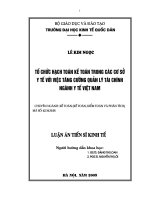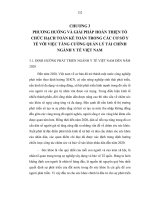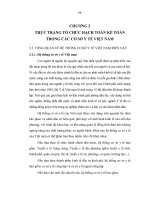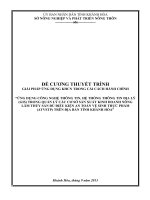ĐẠI CƯƠNG QUẢN LÝ CÁC CƠ SỞ Y TẾ - PGS, TS LÊ HOÀNG NINH
Bạn đang xem bản rút gọn của tài liệu. Xem và tải ngay bản đầy đủ của tài liệu tại đây (869.46 KB, 22 trang )
ĐẠI CƯƠNG
QUẢN LÝ CÁC CƠ SỞ Y TẾ
PGS, TS LÊ
Ê HOÀNG
À
NINH
VIỆN VỆ SINH Y TẾ CÔNG CỘNG
MANAGING ORGANIZATIONS
1-BASIC CONCEPT
MANAGING ORGANIZATIONS
BASIC CONCEPT ( WHO)
– MANAGEMENT : A SYSTEMATIC PROCESS OF
USING RESOURCES WITH
JUDGEMENT TO ACHIEVE
OBJECTIVES
– MANAGEMENT : GETTING DONE THROUGH
PEOPLE
1. PLANNING WHAT SHOULD BE DONE ( OBJECTIVES)
2. TAKING ACTION THROUGH PEOPLE ( ACTIVITIES)
3. PROVIDING FOR ITS CONSEQUENCES ( EFFECTS) TO BE
ASSESSED ( EVALUATION), USING RESULTS OF STEP 3 AS
INFORMATION FOR FEEDBACK STEPS 1 AND 2
4. CORRECT SUBSEQUENT ACTION
2-THE ORGANIZATION AND ITS
ENVIRONMENT
An organization exists to perform work
By activities transform inputs into outputs
Organization can be any size: health
center, district health service, hospital,
department within a hospital, provincial
headquarters, a programmed, ministry of
health
2-THE ORGANIZATION AND ITS ENVIRONMENT
2-THE ORGANIZATION AND ITS ENVIRONMENT
Inputs :
materials
staff
resource of money
In health organizations:
…
communities
patients
trainees
students
d
2-THE ORGANIZATION AND ITS ENVIRONMENT
Activities: according to purpose of
organizations
– Factoryy : manufacturing,
g, packing,
p
g, marketing…
g
– Health org. : chẩn đoán, điều trị, điềi dưỡng,
p.h.c.n, dụ phong, gdsk…
– Managerial acyivities: supervision, co
co-ordination, finalcial control, communications…
– Transform
T
f
iinputs
t -> outputs
t t : llab
b reports,
t
patients discharged, examination, students
completed
p
training…
g
2-THE ORGANIZATION AND ITS ENVIRONMENT
Interdependence between org
org. and its
environment:
– Demography and morbidity
– Economic and finance
– Social and cultural
– Legislation and political
– Technological
T h l i l and
d professional
f i
l
3.
3 EVALUATION
Evaluation :
– How the organization is working and affecting
that community
– The feedback role of evaluation:
Comparing effects with objectives by finding out
what is happening compared with what is intended
or need to happen
Using these information to take corrective actions
where necessary and feasible in the way the
organization
g
functions
3.
3 EVALUATION
TWO BROAD TYPES:
1. Efficiency: by examine quantity, quality, cost and
speed of outputs by comparing with the input and
activities which have produced them
Whatever the org. doing within itself, how efficiency? :
accurately, speedily, cheaply?
2. Effectiveness: comparing outcome of organizational
functioning with needs and objectives
–
Not how efficiently is the org
org. producing its outputs but
what impact is that working having on the community
health?
4. FOUR TYPES OF MANAGEMENT
1.
–
2
2.
–
3.
–
4.
–
Maintainance management
Characteristic skills : problem solving, decision making,
managing time and priorities, managing staff, finance and
materials
Integrative management
Typical skills: leadership, motivation, communications,
interpersonal relations and team building
Evaluation management
Required skills: work analysis, objective and standard setting,
information and analysis, monitoring individual and
organizational performance, auditing and judging
Ad ti management:
Adaptive
t achieving
hi i change
h
in
i the
th
organization’s functioning or direction
Skills : analyzing the environment, forecasting and planning,
creative thinking,
thinking innovating and implementing change
3-MANAGERIAL NEEDS OF HEALTH ORGANIZATIONS
MANAGERIAL NEEDS OF HEALTH
ORGANIZATION
Complex,
p , manyy departments
p
and professions
p
or being
g
scattered over distant location
Labor--intensive, working requires a large workforce:
Labor
various individual skills and form of care
care--> human
service
Dealing with vital issues of life
R l increasingly
Rely
i
i l on community
it participation
ti i ti and
d interinter
i t sectoral collaboration to achieve better health
To be managed
g as economicallyy and productively
p
y as
possible
Having to change to response to new pattern of illness
APPROACHES TO CHANGE
Health care org. affected by many forces from
both within and outside: changing demands
Unless management respond to these forces,
the org. move towards a crisis where it no
longer can cope with the demands being placed
upon it
Org. change: the process of planned transition
f
from
a present unsatisfactory
f
situation in the
h
org. towards an improved future
APPROACHES TO CHANGE
Now and then approach:
is more useful for relatively
straightforward change
2. Open planning system:
is appropriate when the change is
more complex
Ex: org. units are being reviewed for
their effectiveness// or external force
1
1.
APPROACHES TO CHANGE
Now and then approach: has a vision of
future for org.
1 Describe what this vision: policies,
1.
policies
resources, attitude, skills, practices…
2 Discover what is happening now: careful
2.
investigation and analysis. Note: do not
assume that…
3. Comparison then with now: what needs
changing
APPROACHES TO CHANGE
The Open system planning: takes into account
the:
Core mission ( its reason for existence) and Inputs to
become outputs
become
Demand by environment
Core mission : what business are we in? it is the
reason why the organization exits, is decided by
top
p management
g
Demands by environment ( figure)
Make explicit what demand or demands of each domain
THE OPEN
SYSTEM
PLANNING
MANAGING THE CHANGE
Organization framework: change one
part, effect on many other parts
The 7 “S”
S framework:
1.
2.
3.
4.
5
5.
6.
7.
S
S
S
S
S
S
S
uperordinate goal
tructure
trategy
ystem
tyle
taff
kills
THE 7”S” FRAMEWORK
FORCE FIELD ANALYSIS









